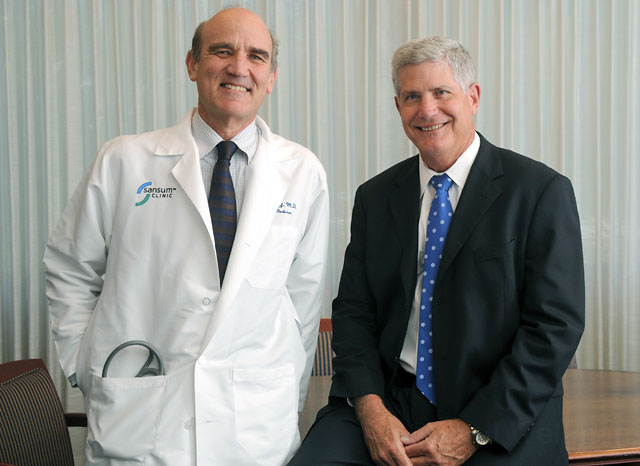Cottage, Sansum Pull Plug on Merger Application
Health Care Organizations Waited Four Years for FTC Decision

After pursing for nearly four years a merger that would have fused the inpatient care power of Cottage Health and the outpatient prowess of Sansum Clinic, executives of both health-care enterprises announced last week they were pulling the plug. Ron Werft, CEO of Cottage, and Kurt Ransohoff, CEO of Sansum, expressed frustration with the Federal Trade Commission (FTC), the agency charged with screening potential mergers for their monopolistic impacts.
“Over the years, we found we were waiting to hear, waiting to hear, waiting to hear,” said Ransohoff. “We just finally came to the conclusion that … we would not be able to clarify things and that going down the path we’ve been going down wasn’t going to have a good ending.” Werft experienced similar challenges trying to understand what the FTC actually wanted. “They don’t give you a recipe; they give you a list of concerns, and then you have to figure out how to respond,” he said. “But it just goes on and on and on. They have no deadlines.” This is the second time in almost nine years that Cottage and Sansum — the two 900-pound health-care gorillas on the South Coast — have submitted applications for a merger. Both times, they have had to withdraw them.
Throughout the recent attempt, Cottage and Sansum made a strategic decision not to speak in public about the merger except when necessary. Few details of the application — which involve reams of proprietary trade information — were shared with the public. About 18 months ago, however, Werft and Ransohoff explained that the FTC had expressed concerns that, because both entities own and operate outpatient surgical centers, the merger might result in a loss of competition. That could be a deal killer. Cottage, in response, found an independent buyer for its surgical centers. That sale, however, was conditional on the merger being approved. Werft explained, “They [the FTC] still are unconvinced that that transaction would result in sufficient competition ….”.
While the surgical centers provide a key community service, they represent a relatively small volume of revenue for Cottage and Sansum. One well-placed medical observer stated that area doctors affiliated with Sansum had been solicited by the prospective operator-owner of the surgical center to become partner-investors in the new enterprise. This is a common method used to ensure a high volume of referrals. If accurate, such partnerships might have undermined the arm’s-length effect the FTC had hoped to achieve by divestment.
The merger would have allowed Cottage and Sansum to integrate the largest outpatient ambulatory care clinic in the county with the largest hospital enterprise in the county and the only one on the South Coast. The Centers for Medicare & Medicaid Services, the federal branch overseeing health-care payments, generally approves of these mergers because they can better control costs while maintaining a higher level of service, at least as measured by hospital patient readmission. Nearby, Kaiser and UCLA both provide large-scale examples of this. Of course, they exist in large population centers where there are several hospitals. The size of Cottage Health — which operates in the smaller communities of Santa Barbara, Goleta, and Santa Ynez — would be a cause of concern for FTC regulators, charged with protecting consumers from monopolies that would affect costs and quality of care.
If the merger application is dead, the economic forces that gave rise to two such applications in the past decade are still very much alive and well. UCLA — which owns a hospital and health clinic in Los Angeles — has expressed interest in the Santa Barbara market. Last year, for example, UCLA explored buying a series of South Coast private clinics. Ultimately, they decided against it. With or without the Affordable Care Act, federal health-care bureaucracies are shifting away from traditional fee-for-service reimbursement formulas that have defined health-care economics for decades. Instead, they’re recalculating reimbursement requirements in such a way that maximizes rewards for operations that can keep costs low while delivering measurable levels of service. “There’s kind of two different parts of the federal government, one encouraging collaboration, saying, ‘This is the way to go,’ and the other saying, ‘Be careful; this may not be a good thing,’” Werft stated. “We’ve just been stuck between those two.”
Under the Barack Obama administration, the FTC had grown increasing hostile to health-care mergers. Under a Trump administration, presumably, that might change. If so, neither Werft nor Ransohoff were inclined to test the waters. “It doesn’t appear there’s going to be any change in the FTC soon,” said Werft, who noted that three of the five positions on the commission are currently vacant.
For independent physicians in town — unaffiliated with either health-care organization — news that the merger application has been suspended comes as a relief, however temporary. Knowledgeable health-care observers predict Cottage and Sansum will either continue to pursue ways to integrate the two operations without formally merging or they will be forced to form partnerships with an entity like Kaiser or UCLA. “We’ve been cooperating for about 100 years,” said Ransohoff. “We’re not about to stop now.”
The original version of this story has been replaced with an updated report. A correction was made May 18 to reflect that UCLA, not Kaiser, has been interested in the Santa Barbara market.



